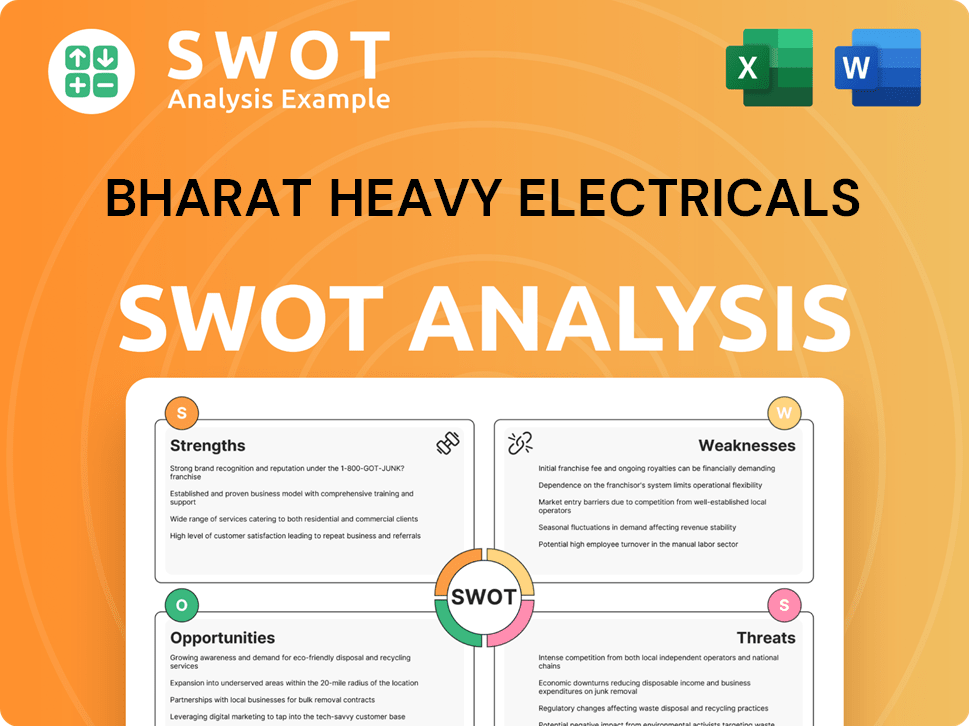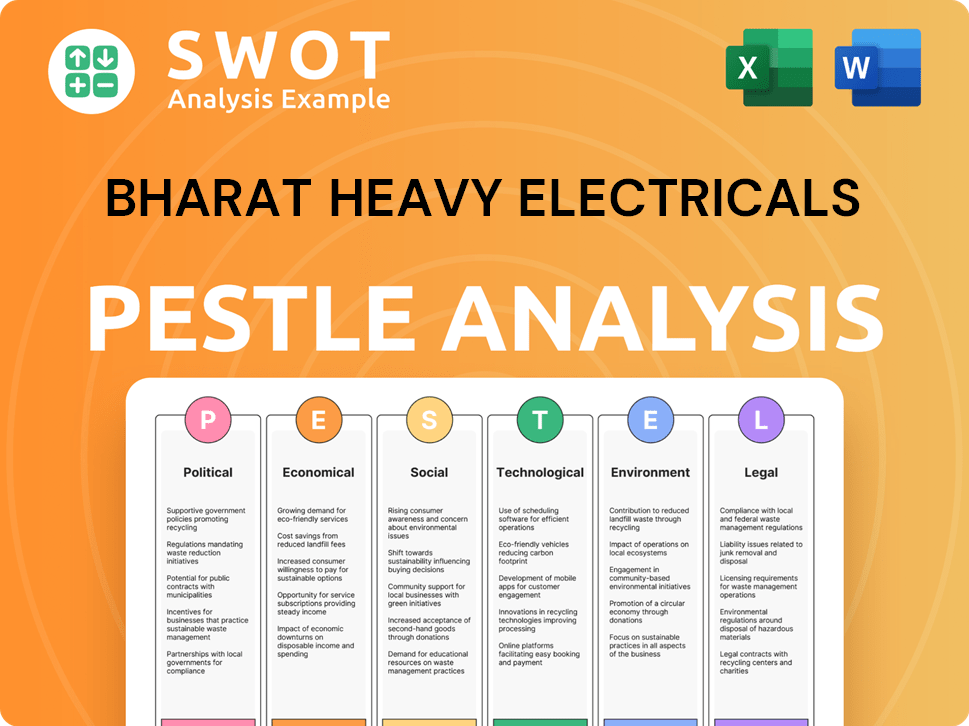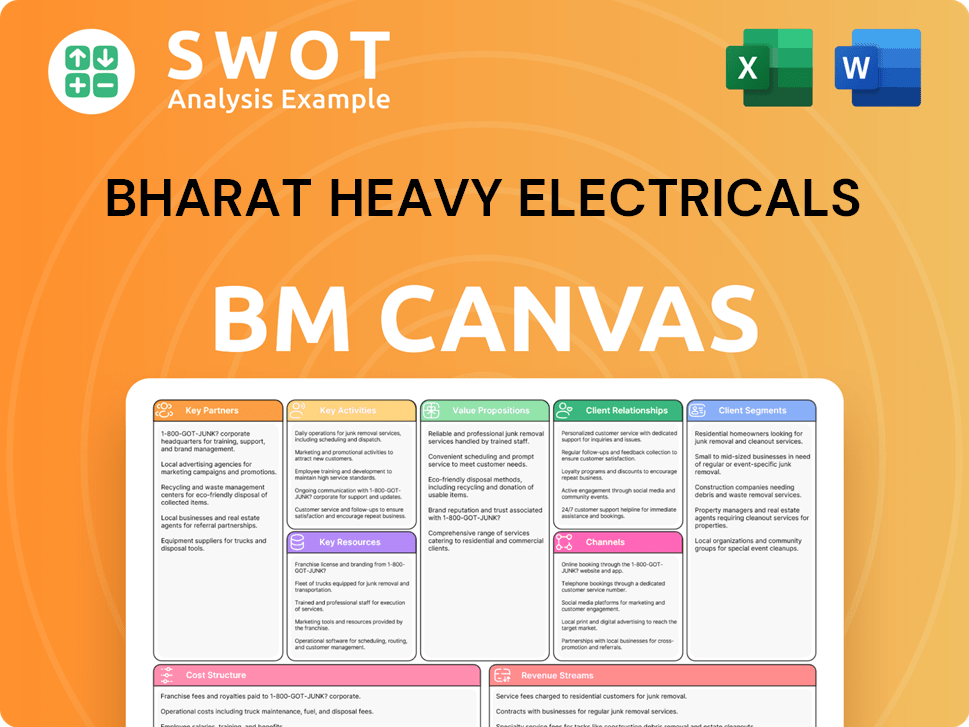Bharat Heavy Electricals Bundle
How has Bharat Heavy Electricals Limited Shaped India's Industrial Landscape?
Bharat Heavy Electricals Limited (BHEL) is a giant in India's industrial story, a story of self-reliance and engineering prowess. Established in 1964, BHEL was born from a vision to build India's capacity in critical sectors, especially power generation. Its journey is a testament to India's growth and ambition.

Delving into the Bharat Heavy Electricals SWOT Analysis reveals the strategic depth of this public sector undertaking. From its early days, BHEL has played a crucial role in the Indian power sector, contributing significantly to power generation and infrastructure development. Understanding the BHEL history provides valuable insights into its evolution, key milestones, and its impact on the Indian economy. Its manufacturing plants and diverse products and services have solidified its position in heavy engineering India.
What is the Bharat Heavy Electricals Founding Story?
The story of Bharat Heavy Electricals Limited (BHEL) is a significant chapter in the evolution of India's industrial landscape. Officially incorporated on November 13, 1964, the roots of BHEL extend back to August 29, 1956, with the establishment of Heavy Electricals (India) Limited (HE(I)L). This marked the beginning of a journey aimed at achieving self-sufficiency in the heavy electrical equipment sector, a crucial step for post-independence India's economic and industrial growth.
The Indian government founded BHEL with a clear vision. The primary goal was to build a robust manufacturing base to support the country's power generation and infrastructure needs. This initiative was critical for driving economic development and reducing dependence on foreign imports of essential equipment. The company quickly became a key player in the Indian power sector, contributing significantly to the nation's energy capacity.
The initial groundwork for BHEL's operations was coordinated from Bhopal until November 1964. BHEL strategically established its manufacturing plants in key locations across India. These included Tiruchirappalli, Tamil Nadu, for high-pressure boilers; Hyderabad, Telangana, for steam turbo generators and high-pressure pumps and compressors (with collaboration from Czechoslovakia); and Haridwar, Uttarakhand, for large steam turbo generating sets, motors, and hydro generating sets (with collaboration from the erstwhile USSR). HE(I)L merged with BHEL in 1974, consolidating its operations. The original business model revolved around manufacturing heavy electrical equipment, primarily for the power sector, including boilers, turbines, and generators. This was driven by the government's commitment to boost the country's power generation capacity.
BHEL's establishment was a strategic move by the Indian government to achieve self-reliance in heavy electrical equipment.
- The initial focus was on manufacturing equipment for the power sector, including boilers, turbines, and generators.
- Key manufacturing plants were strategically located in Tiruchirappalli, Hyderabad, and Haridwar.
- HE(I)L's merger with BHEL in 1974 consolidated operations and resources.
- BHEL's mission and values are further detailed in Mission, Vision & Core Values of Bharat Heavy Electricals.
Bharat Heavy Electricals SWOT Analysis
- Complete SWOT Breakdown
- Fully Customizable
- Editable in Excel & Word
- Professional Formatting
- Investor-Ready Format

What Drove the Early Growth of Bharat Heavy Electricals?
The early growth and expansion of Bharat Heavy Electricals Limited (BHEL) marked a significant period of diversification and contribution to India's power generation capabilities. This phase saw BHEL evolving from its initial focus to encompass a broader range of products and services. The company's strategic initiatives during this time laid the groundwork for its future growth and its enduring impact on the Indian power sector.
In the 1970s, BHEL expanded its manufacturing capabilities to include a wider array of power plant equipment, such as boilers, turbines, and generators. A key technological advancement was the collaboration with Kraftwerke Union (KWU) of Germany in 1974-75. This partnership was crucial for the design and technology of thermal generating sets, specifically those above 210 MW and up to 1,000 MW. This collaboration significantly enhanced BHEL's technological prowess and its ability to compete in the heavy engineering India market.
BHEL's international journey began with its first export order to Malaysia during this period, marking its initial steps into the global market. By the end of the 1970s, BHEL adopted a 'systems concept,' providing comprehensive services from conceptualization to commissioning. This approach catered to customers in the energy, industry, and transportation sectors. This comprehensive service model set BHEL apart in the BHEL history.
The 1980s witnessed BHEL achieving a major milestone by producing its 1000 MW thermal set. It also diversified into the transportation sector, manufacturing electric locomotives. In 1991, BHEL was converted into a public company, which was a significant step in its evolution. The 1990s saw a focus on globalization, with BHEL expanding its product exports. BHEL also ventured into non-conventional energy systems during this time.
In FY 2015-16, BHEL achieved an all-time high commissioning of 15,059 MW of power generating equipment. This increased the worldwide installed base of BHEL-supplied power generating equipment to over 170 GW. The Indian utility segment added 13,061 MW, a 59% increase over the previous year. The company secured its highest order booking in five years, totaling ₹43,727 crore, with ₹38,529 crore from the Power segment and ₹5,125 crore from the Industry segment, ending the year with an order book exceeding ₹1,10,000 crore. For more information about the company's structure, you can read about the Owners & Shareholders of Bharat Heavy Electricals.
Bharat Heavy Electricals PESTLE Analysis
- Covers All 6 PESTLE Categories
- No Research Needed – Save Hours of Work
- Built by Experts, Trusted by Consultants
- Instant Download, Ready to Use
- 100% Editable, Fully Customizable

What are the key Milestones in Bharat Heavy Electricals history?
The BHEL history is marked by significant achievements in the Indian power sector and heavy engineering India. The company has consistently delivered on critical projects and expanded its technological capabilities, contributing significantly to the nation's infrastructure development.
| Year | Milestone |
|---|---|
| January 2023 | Successful commissioning of India's first thermal power plant with an Air Cooled Condenser (ACC) at NTPC North Karanpura Super Thermal Power Project Unit-1, reducing water footprint. |
| December 2019 | Kaiga power plant, where BHEL-supplied equipment enabled Unit 1 to set a world record for continuous operation at 962 unbroken days. |
| 2024 | BHEL received its first order for the demonstration of methanol firing in a Gas Turbine at the 350 MW Kayamkulam Combined Cycle Power Plant of NTPC. |
BHEL has consistently introduced innovative solutions across various sectors. These innovations have not only enhanced operational efficiency but also contributed to sustainable practices in power generation and transportation.
BHEL supplied the first WAG-7 Regenerative Locomotive to Electric Loco Shed, Jhansi, showcasing its expertise in the transportation sector. This innovation improved energy efficiency in rail operations.
BHEL has emerged as a leading player in floating solar, commissioning 152 MW of floating solar plants. This initiative highlights the company's commitment to renewable energy.
BHEL achieved a major breakthrough with the world's first indigenous High Ash Coal Gasification Plant, converting coal to methanol. This technology supports sustainable energy practices.
BHEL has been supplying critical nuclear components since 1976, contributing to the nation's nuclear power program. This demonstrates BHEL's long-term commitment to the sector.
BHEL received an order for 80 Vande Bharat Trains in a consortium with TWL. This project will boost the company's presence in the rail transportation sector.
BHEL successfully demonstrated flexible operations at the 1x600MW Adani Raigarh thermal power plant. This helps in improving the efficiency of power generation.
Despite these achievements, BHEL faces challenges related to market dynamics and competition. The company is adapting to the evolving energy landscape and focusing on diversification and efficiency improvements.
Economic slowdowns and increased competition in the 2010s put pressure on BHEL's profit margins. The company has had to navigate intense competition from both domestic and international players.
A high dependence on the Indian market and difficulties in adapting to rapidly changing global energy trends pose challenges. BHEL is working to diversify its business portfolio to mitigate these risks.
Profit margins have been under pressure due to intense competition and shifts in the global energy landscape. BHEL is focusing on project execution and operational efficiency to address this.
BHEL has shifted from a 'revenue-centric' to a 'project-centric' strategy to improve project execution and operational efficiency. This strategic shift aims to enhance overall performance.
In Q4 FY25, BHEL reported a 3.03% rise in net profit to ₹504.45 crore, with revenue from operations increasing by 8.88% to ₹8,993.37 crore. The company's total income for FY 2024-25 increased to ₹28,804.79 crore.
BHEL is focusing on diversifying its business portfolio into areas like renewable energy, transportation, and defense. This strategy is designed to secure long-term growth.
Bharat Heavy Electricals Business Model Canvas
- Complete 9-Block Business Model Canvas
- Effortlessly Communicate Your Business Strategy
- Investor-Ready BMC Format
- 100% Editable and Customizable
- Clear and Structured Layout

What is the Timeline of Key Events for Bharat Heavy Electricals?
The BHEL history is marked by significant milestones, from its establishment to its current position as a key player in the Indian power sector. Initially registered in 1956 as Heavy Electricals (India) Limited, the company was formally incorporated as Bharat Heavy Electricals Limited in 1964. Over the years, BHEL has evolved, merging with Heavy Electricals (India) Limited in 1974 and expanding its operations to include diverse products and services. The company has consistently adapted to technological advancements and market demands, playing a crucial role in BHEL's role in Indian infrastructure and contributing significantly to the nation's power generation capabilities.
| Year | Key Event |
|---|---|
| 1956 | Heavy Electricals (India) Limited (HE(I)L) was registered in the Public Sector. |
| 1964 | Bharat Heavy Electricals Limited (BHEL) was formally incorporated on November 13, consolidating three new heavy electrical equipment manufacturing plants. |
| 1974 | Heavy Electricals (India) Limited merged with BHEL. |
| 1974-75 | BHEL collaborated with Kraftwerke Union (KWU) of Germany for thermal generating sets. |
| 1980s | BHEL produced its 1000 MW thermal set and diversified into electric locomotive manufacturing. |
| 1990s | BHEL focused on globalization and became the first public sector company to obtain ISO 9000 and ISO 14000 accreditations. |
| 2015-16 | Achieved highest-ever commissioning of projects (15,059 MW) and highest order booking in five years (₹43,727 Crore). |
| 2019 | BHEL-supplied equipment at Kaiga 1 nuclear power plant set a world record for 962 unbroken days of continuous operation. |
| 2021 | Secured its largest-ever order of ₹10,800 crores from NPCIL for EPC of a turbine island for 6 units of 700 MW. |
| January 2023 | Commissions India's first thermal power plant with an Air Cooled Condenser at NTPC North Karanpura. |
| 2022-23 | Reported overall revenue growth of approximately 10% to ₹221.36 billion and profit after tax (PAT) increase of 9.3% to ₹4.48 billion. |
| September 2024 | Received its first order for the demonstration of methanol firing in a Gas Turbine at NTPC's Kayamkulam plant. |
| FY 2024-25 (Provisional) | Registers revenue of ₹27,350 crore (19% growth) and highest-ever order inflows of ₹92,534 crore, with a total order book of ₹1,95,922 crore. |
| May 2025 | Reports Q4 FY25 net profit of ₹504.45 crore, up 3.03% from Q4 FY24, and full-year FY25 consolidated net profit of ₹533.90 crore, up from ₹282.22 crore in FY24. |
BHEL's strategic plan for 2022-27 aims to transform it into a 'future-ready global engineering organisation'. This involves diversifying into new products and services and achieving technological self-sufficiency. The company is focusing on renewable energy, energy-efficient solutions, and innovative technologies. This includes expansion into battery energy storage systems (BESS) and electric vehicle (EV) chargers.
The company's financial performance in FY25 shows strong growth. Provisional revenue for FY25 reached ₹27,350 crore, reflecting a 19% increase, and the highest-ever order inflows of ₹92,534 crore. The total order book stands at ₹1,95,922 crore. Analysts predict BHEL's share price could range from ₹165 to ₹280 in 2025, with some forecasts suggesting an average price target of ₹261.80.
BHEL is actively pursuing opportunities in renewable energy, including solar and wind power. Strategic partnerships, such as the joint venture with Coal India Limited (CIL) for ammonium nitrate production, are also crucial. The company's commitment to delivering high-impact infrastructure and driving indigenization aligns with its founding vision.
BHEL is expanding into emerging sectors like battery energy storage systems (BESS) and electric vehicle (EV) chargers. The company's focus on energy-efficient solutions and innovative technologies supports its growth. BHEL's demonstration of methanol firing in a Gas Turbine at NTPC's Kayamkulam plant highlights its technological advancements.
Bharat Heavy Electricals Porter's Five Forces Analysis
- Covers All 5 Competitive Forces in Detail
- Structured for Consultants, Students, and Founders
- 100% Editable in Microsoft Word & Excel
- Instant Digital Download – Use Immediately
- Compatible with Mac & PC – Fully Unlocked

Related Blogs
- What is Competitive Landscape of Bharat Heavy Electricals Company?
- What is Growth Strategy and Future Prospects of Bharat Heavy Electricals Company?
- How Does Bharat Heavy Electricals Company Work?
- What is Sales and Marketing Strategy of Bharat Heavy Electricals Company?
- What is Brief History of Bharat Heavy Electricals Company?
- Who Owns Bharat Heavy Electricals Company?
- What is Customer Demographics and Target Market of Bharat Heavy Electricals Company?
Disclaimer
All information, articles, and product details provided on this website are for general informational and educational purposes only. We do not claim any ownership over, nor do we intend to infringe upon, any trademarks, copyrights, logos, brand names, or other intellectual property mentioned or depicted on this site. Such intellectual property remains the property of its respective owners, and any references here are made solely for identification or informational purposes, without implying any affiliation, endorsement, or partnership.
We make no representations or warranties, express or implied, regarding the accuracy, completeness, or suitability of any content or products presented. Nothing on this website should be construed as legal, tax, investment, financial, medical, or other professional advice. In addition, no part of this site—including articles or product references—constitutes a solicitation, recommendation, endorsement, advertisement, or offer to buy or sell any securities, franchises, or other financial instruments, particularly in jurisdictions where such activity would be unlawful.
All content is of a general nature and may not address the specific circumstances of any individual or entity. It is not a substitute for professional advice or services. Any actions you take based on the information provided here are strictly at your own risk. You accept full responsibility for any decisions or outcomes arising from your use of this website and agree to release us from any liability in connection with your use of, or reliance upon, the content or products found herein.